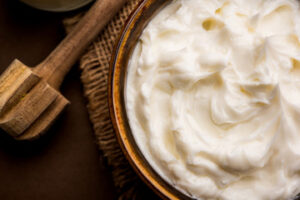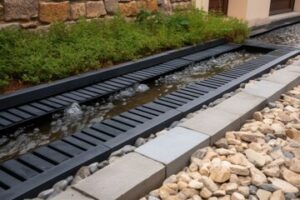Body Butter is like a thicker, waterless version of lotion that deeply moisturizes the skin and prevents dryness. It also helps improve skin texture and fades the appearance of fine lines and blemishes for a more youthful appearance.

Use a clean scoop or spoon to take a small amount out and massage it onto your skin, concentrating on dry spots such as elbows and knees.
Body butter is a skin care staple because it deeply moisturizes the skin to help keep it supple and healthy. Its emollient ingredients like shea and cocoa butter soothe the skin while helping to prevent dryness. The oil-based formula also helps to seal the moisture in for longer, so it doesn’t evaporate too quickly.
The best time to apply body butter is straight out of the shower when your skin is still slightly damp. Be careful not to overdo it though as too much may cause clogged pores. A little bit goes a long way, so start small and then add more as needed. Also, make sure to focus on driest areas such as elbows, knees, and hands.
Body Butter can be used on its own or in conjunction with a body oil to really lock in the moisture. It can even be used on the face to treat drier areas such as around the mouth or on the eyes.
Its rich, nourishing, and hydrating ingredients can help improve the appearance of age spots and hyperpigmentation. Regular use can also help prevent creases, wrinkles, and dark circles under the eyes. The vitamins and antioxidants found in body butter can also help to protect the skin against environmental pollution.
While it is generally recommended to use a moisturizing oil before applying body butter, there are exceptions to this rule. Body butter can be applied over the body oil if it is made from natural oils that are known to be gentle and hydrating.
A good quality body butter will usually contain skin-friendly, non-comedogenic oils such as shea, jojoba, and sunflower. It should also be free from parabens, phthalates, synthetic dyes, and other harsh additives that can irritate the skin.
When choosing a body butter, look for one that has no added water so you’ll have the full benefits of the oil-based ingredients. Whipped body butters are particularly beneficial because they can have a soft, fluffy texture that is easier to spread and blend. They can have a light scent and can be made with glycerin, which helps to keep the body butter from collapsing as it’s being spread. Some will also have a stabilizing ingredient such as arrowroot powder to help prevent the butter from breaking down.
Nourishes
Body butter is known to nourish and revitalize the skin. It is rich in vitamins, minerals, antioxidants and other essential fatty acids. This helps to repair dry, damaged, and flaky skin. It also improves skin elasticity and reduces stretch marks. It gives the skin a soft, youthful glow and provides hydration for longer. It can be used on the whole body, including the sensitive areas like hands and feet. The best time to apply body butter is after a shower or bath. This allows the product to fully absorb into the skin before you put on your clothes.
Scoop a small amount of body butter with a clean spoon or your fingers and spread it over your entire body. Be sure to apply it to super dry spots like elbows and heels. Once your body is covered, gently massage the product into your skin using circular motions. Then, let it sit for a few minutes so that the ingredients can fully penetrate into your skin.
It is also important to store your body butter properly. Avoid exposing it to heat sources and sunlight, as this can cause it to melt or lose its texture. It is also recommended to use a clean scoop or spoon, and to tightly seal the container after each use. This will minimize the introduction of contaminants into the product and prolong its shelf life.
There are several different kinds of body butter available on the market. Some are made with shea butter, which is a highly-recognized moisturizing ingredient that can help to repair dry and damaged skin. Cocoa butter is another popular choice, as it can give your skin a soft, smooth, and rejuvenated look.
You can also try a luxurious body butter that is infused with a blend of natural extracts. This can include saffron, jasmine, and lavender. This kind of body butter is known to soothe your skin, reduce blemishes, and give your skin a beautiful, natural glow. This is a great way to pamper yourself, and it will also help your skin look younger and more vibrant!
Prevents Dryness
Whether your skin is normal, dry or oily, the right body butter can make all the difference. Body butter is typically thicker than a lotion and contains a blend of naturally derived butters (like shea, murumuru, mango and cocoa) along with essential oils like coconut oil and rosehip oil. It is rich and nourishing, providing deep hydration for your skin.
It is also a great option for anyone who experiences dryness or itchiness because of a specific skin condition, such as eczema. The hydrating ingredients, along with the fact that it can be applied generously, can provide relief from the symptoms of these conditions. Just make sure to patch test any new products on your skin before use to ensure they don’t aggravate them.
Applying body butter can be done on both wet and dry skin, although it works best when your skin is damp. The moisture from the shower and the warm water can help lock in the body butter, allowing your skin to soak it up quickly. It is also a good idea to apply it on any areas that are especially dry, such as your elbows and knees. These areas tend to lose hydration more quickly because of friction with clothing, shoes and other items that you wear or touch throughout the day.
When you apply body butter, you should wait a couple of minutes before getting dressed or showering so that your skin can absorb the moisturizer. Then, you can reapply it as needed throughout the day.
Aside from using it on your hands, you can also slather a little body butter on your feet before putting on a pair of socks at night. This helps seal in the moisture so your feet can stay hydrated during the night. It is also a great idea to slather on some body butter on your cuticles, as well, to keep them hydrated and prevent dryness.
Hydrates
A body butter is a luxurious concoction of oils, butters and natural extracts that can give your skin the deep hydration it needs to stay healthy and glowing. Unlike lotions and creams, these thick body moisturizers are formulated without water to help your skin feel supple and smooth, while also nourishing it with essential vitamins and minerals.
Because they have a high concentration of hydrating ingredients, body butters are ideal for dry and itchy skin. They can also help reduce the appearance of stretch marks, scars and wrinkles. Using a body butter regularly can also help prevent flaking, redness and inflammation caused by eczema, sunburn or other skin irritations.
While there are a wide range of body butters on the market, not all are created equal. A good body butter should contain a blend of natural and organic ingredients, and will be free of synthetic fragrances and dyes. It should also be free of harmful chemicals and parabens, which are commonly found in many mass-produced body creams. If you are looking for a natural body butter, it’s best to choose one that is made from shea or cocoa butter and contains no added chemicals.
The best time to apply a body butter is right after showering while your skin is still slightly damp. You can use a spatula or your fingers to scoop out a small amount of the butter, and then rub it onto your skin using a circular motion. A little goes a long way, and you can focus on particularly dry areas of your skin like your feet, elbows and knees.
Once you’ve applied your body butter, wait a few minutes for it to soak in, and then rinse it off with warm water. If you have particularly dry skin, you can also apply it before going to bed and then wear cotton socks or gloves overnight. This will help the moisture sink in and keep your skin hydrated throughout the night.
If you’re looking for an even more intense hydration treatment, try applying body butter before and after your workout. This will help lock in the moisture and keep your skin nourished and healthy all day long.
